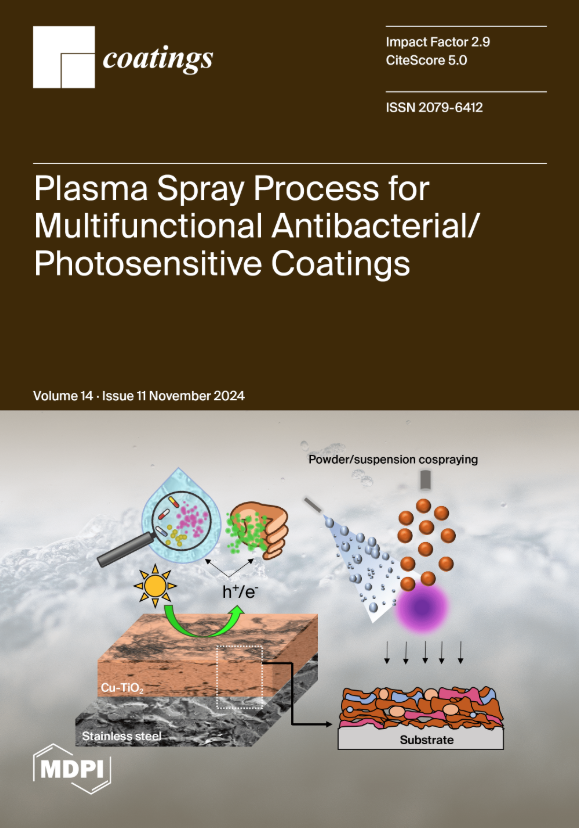Improvement of Fatigue Strength in Additively Manufactured Aluminum Alloy AlSi10Mg via Submerged Laser Peening
IF 2.8
3区 材料科学
Q2 MATERIALS SCIENCE, COATINGS & FILMS
引用次数: 0
Abstract
As the fatigue properties of as-built components of additively manufactured (AM) metals are considerably weaker than those of wrought metals because of their rougher surface, post-processing is necessary to improve the fatigue properties. To demonstrate the improvement in the fatigue properties of AM metals via post-processing methods, the fabrication of AlSi10Mg, i.e., PBF–LS/AlSi10Mg, through powder bed fusion (PBF) using laser sintering (LS) and its treatment via submerged laser peening (SLP), using a fiber laser and/or a Nd/YAG laser, was evaluated via plane bending fatigue tests. In SLP, laser ablation (LA) is generated by a pulsed laser and a bubble is generated after LA, which behaves like a cavitation bubble that is referred to as “laser cavitation (LC)”. In this paper, LA-dominated SLP is referred to as “laser treatment (LT)”, while LC collapse-dominated SLP is referred to as “laser cavitation peening (LCP)”, as the impact of LC collapse is used for peening. It was revealed that SLP using a fiber laser corresponded with LT rather than LCP. It was demonstrated that the fatigue strength at N = 107 was 85 MPa for LCP and 103 MPa for the combined process of blasting (B) + LT + LCP, whereas the fatigue strength of the as-built specimen was 54 MPa.通过浸没式激光喷丸强化提高加成制造铝合金 AlSi10Mg 的疲劳强度
增材制造(AM)金属坯件由于表面粗糙,其疲劳性能大大弱于锻造金属,因此有必要进行后处理以改善其疲劳性能。为了证明通过后处理方法可以改善 AM 金属的疲劳性能,我们通过平面弯曲疲劳试验评估了使用激光烧结(LS)通过粉末床熔融(PBF)制造的 AlSi10Mg(即 PBF-LS/AlSi10Mg),以及使用光纤激光和/或 Nd/YAG 激光通过浸没式激光强化(SLP)对其进行的处理。在 SLP 中,脉冲激光会产生激光烧蚀 (LA),LA 后会产生气泡,其行为类似于空化气泡,被称为 "激光空化 (LC)"。在本文中,以 LA 为主导的 SLP 被称为 "激光处理(LT)",而以 LC 塌陷为主导的 SLP 被称为 "激光空化强化(LCP)",因为 LC 塌陷的影响被用于强化。研究表明,使用光纤激光器的 SLP 与 LT 相对应,而与 LCP 相对应。结果表明,在 N = 107 时,LCP 的疲劳强度为 85 兆帕,喷砂 (B) + LT + LCP 组合工艺的疲劳强度为 103 兆帕,而竣工试样的疲劳强度为 54 兆帕。
本文章由计算机程序翻译,如有差异,请以英文原文为准。
求助全文
约1分钟内获得全文
求助全文
来源期刊

Coatings
Materials Science-Surfaces, Coatings and Films
CiteScore
5.00
自引率
11.80%
发文量
1657
审稿时长
1.4 months
期刊介绍:
Coatings is an international, peer-reviewed open access journal of coatings and surface engineering. It publishes reviews, research articles, communications and technical notes. Our aim is to encourage scientists to publish their experimental and theoretical results in as much detail as possible. There is no restriction on the length of the papers. Full experimental and/or methodical details must be provided. There are, in addition, unique features of this journal:
* manuscripts regarding research proposals and research ideas will be particularly welcomed
* electronic files or software regarding the full details of the calculation and experimental procedure - if unable to be published in a normal way - can be deposited as supplementary material
 求助内容:
求助内容: 应助结果提醒方式:
应助结果提醒方式:


